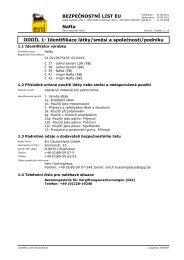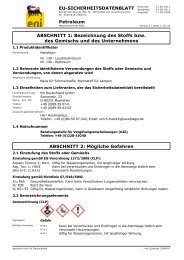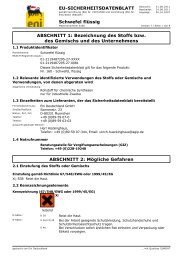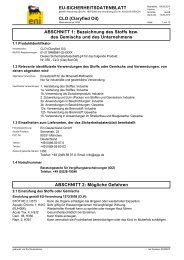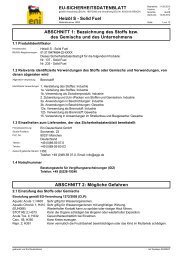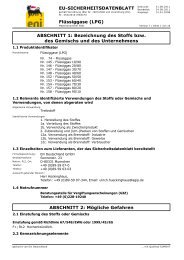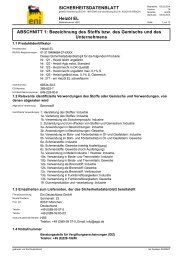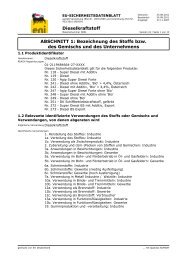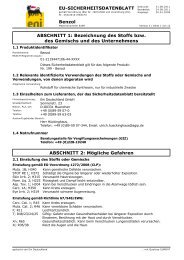EU-SICHERHEITSDATENBLATT Dieselkraftstoff ... - Schmierstoffe
EU-SICHERHEITSDATENBLATT Dieselkraftstoff ... - Schmierstoffe
EU-SICHERHEITSDATENBLATT Dieselkraftstoff ... - Schmierstoffe
You also want an ePaper? Increase the reach of your titles
YUMPU automatically turns print PDFs into web optimized ePapers that Google loves.
Vacuum Gas Oils, Hydrocracked Gas Oils, and Distillate Fuels<br />
oils and distillate fuels, a conservative read across is conducted to Cracked Gas Oils. This read<br />
across is considered conservative as this category has a higher degree of hazard and subsequently<br />
classification.<br />
The category approach has been applied to all relevant physical-chemical, toxicological and<br />
ecotoxicological endpoints listed in column 1 of Annexes VII, VIII, IX and X of the REACH Regulation.<br />
Where a specific endpoint is not considered applicable to substances in this category a justification is<br />
provided<br />
3. Data template and conclusions per endpoint for<br />
C&L, PBT/vPvB and dose descriptor<br />
‣ Physical-Chemical Properties (Section 7 of REACH Annexes VII-X)<br />
Vacuum Gas Oils, Hydrocracked Gas Oils & Distillate Fuels are produced to meet performance<br />
specifications. Typical values / ranges are given in Table 1.<br />
Table 1: Typical physical-chemical endpoint data for vacuum gas oils, hydrocracked gas oils and<br />
distillate fuels<br />
Endpoint 2<br />
7.1 State of the<br />
substance at 20o C<br />
and101,3 kPa<br />
Relevance<br />
to<br />
Category<br />
Typical<br />
Value /<br />
Range<br />
Comment<br />
Yes Liquid Vacuum Gas Oils/Hydrocracked Gas<br />
Oils/Distillate Fuels are liquids of low volatility.<br />
7.2 Melting/freezing<br />
Point<br />
No<br />
Not<br />
applicable –<br />
see<br />
comments<br />
Single values for the category or individual<br />
UVCB members are not applicable. To better<br />
describe the physical phase or flow<br />
characteristics of petroleum products, the<br />
pour point is routinely used. The pour point is<br />
the lowest temperature at which movement of<br />
the test specimen is observed under<br />
prescribed conditions of the test (EN ISO<br />
3016). The pour point temperature falls as an<br />
oil’s viscosity increases. For Vacuum Gas<br />
Oil, Hydrocracked Gas Oil & Distillate Fuels<br />
the pour point ranges from -40°C to +6°C.<br />
7.3 Boiling point Yes 141 - 500°C Single values for the category or individual<br />
UVCB members are not applicable.<br />
Indicative values range from 141 to 500°C.<br />
7.4 Absolute density Yes 800 – 910<br />
kg/m 3<br />
Single values for the category or individual<br />
UVCB members are not applicable.<br />
Indicative values for the category for absolute<br />
density range from 800 to 910 kg/m 3 at 15°C.<br />
7.5 Vapour pressure Yes ~0.4 kPa Values for the category indicated that the<br />
vapour pressure is approximately 0.4 kPa.<br />
7.6 Surface tension No Not<br />
applicable –<br />
see<br />
comments<br />
7.7 Water solubility No Not<br />
applicable –<br />
see<br />
In line with REACH Annex VII, data on<br />
surface tension are not required as, based on<br />
structural considerations, surface activity is<br />
not expected or predicted, and surface activity<br />
is not a desired property of the material.<br />
Substance is a hydrocarbon UVCB. Standard<br />
tests for water solubility are intended for<br />
single substances and are not appropriate for<br />
this complex substance.<br />
2 In accordance with Annexes VII to X of REACH<br />
2010-07-30 CSR Appendix 1




